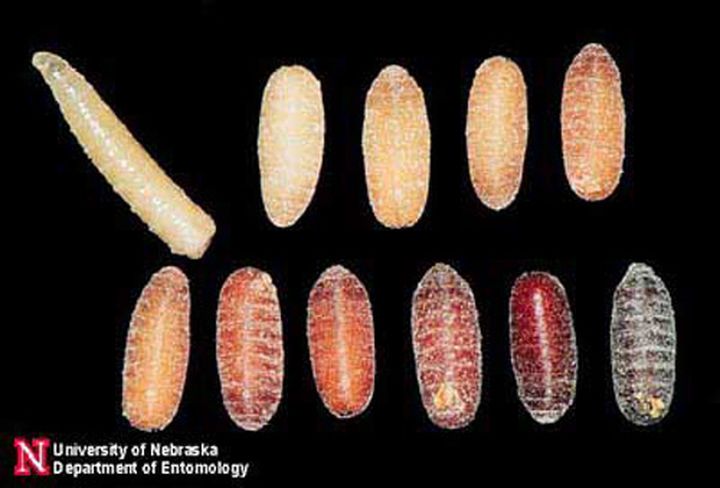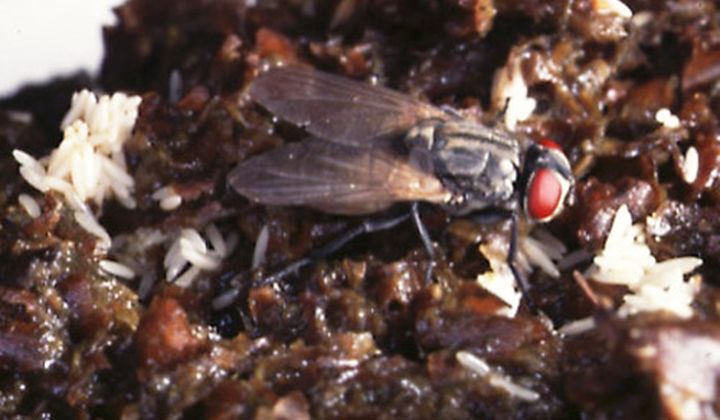Did You Know That Flies Take Power Naps Too?
Here are some not-so-fun-facts about those pesky little houseflies that’s making our lives miserable.

Subscribe to our FREE Newsletter, or Telegram and WhatsApp channels for the latest stories and updates.
Flies are just a pain in our bum, right? If one buzzing fly is annoying enough for us, imagine hundreds of them swarming around us at one time. Torture!
Locals in Bandar Baru Setia Awan Perdana (BBSAP) in Manjung have been suffering from this constant problem of fly infestation as they live near a large chicken farm. In fact, the flies are so abundant here that they can fly into one’s mouth, eyes, ears and nose nonchalantly. Talk about a suicide mission.
Although flies can totally be a nightmare for us, let’s learn more about them to understand them better. The more we know about them, the more efficient we can kill them we can learn in the name of science! 👀

(Credit: University Of Nebraska)
Lifecycle of a housefly
According to School Of Bugs, houseflies (Musca domestic) typically live for about a month (15 – 30 days) and have been recorded to live for a maximum of two months.
Males dedicate most of their lives to finding a female (they prefer 7-day-old females at the prime of their life) while females only need to mate once in their lives. See? Playing hard to get is just wired in evolution.
Females can lay over 500 – 800 eggs in their lifetime and they’ll lay them in batches, each around 100 eggs in a period of days. It only takes a week for a fly to hatch from an egg to a housefly.
The eggs will hatch in a matter of 12-24 hours to produce larvae or what we call those white gross worms on our trash bins – maggots. Maggots will eat their way up until they become a cocoon or pupa (usually in brown).
Then in 4 – 13 days, they’ll hatch again to become an adult fly, set to annoy you for the rest of their lives.

(Credit: University Of Nebraska)
Not-So-Fun-Facts about Houseflies
1. Who needs a tongue when you can taste with your feet?
Flies have taste receptors on their lower legs and feet. So if they wanna know if it’s yummy or not, they’ll simply walk around your garbage, lunch, or manure, to taste it first.
And when they get on a new surface, they’ll rub their hands together first to clean off the previous particles before they taste the new meal.
Besides that, the feet of a housefly are 10 million times more sensitive to sugar than a human tongue. Talk about some serious sweet-foot problem, huh?
2. They are on an all-liquid diet
Because of their lack of teeth, houseflies can only feed on liquids. So why don’t they just attack the orange juice instead of your Sweet & Sour Chicken?
The thing is, they have the ability to change solid food into liquid by spitting or vomiting on it. That’s why you should avoid eating any food after a fly has sat on it, to avoid contamination and well, spit.

3. They’ve got eyes at the back of their heads, sort of…
They don’t need to turn their heads to know you’re coming at them with a swatter.
Flies can see what’s behind them because their vision is close to a 3600 angle. With 5 eyes (two big ones for vision and three small ones for navigation), flies can easily sense movement or danger around them.
Which makes them frustrating to kill!
4. They have beauty sleep too
Flies are typically active during the day, just like us humans too. If they’re too tired during the daytime, they’ll take power naps for 5 to 10 minutes.
But at night time, they will sleep for several hours. They usually sleep at 5 to 15 feet off the ground, and typically on things that have an edge – the edges of walls and furniture, under leaves or stems, garbage cans, fences and more.
So if you spot a fly sitting quietly somewhere, not moving, quickly swat it in its sleep!

5. There’s a correct way to swat a fly
According to a study by CalTech University, despite having small brains, flies are excellent at calculating the angle of a swatting hand, newspaper or swatter and creating a flight plan to avoid it in just milliseconds. They’re good at maths after all.
So with this info, researchers there believe they have found a way to correctly swat a fly, based on their numerous experiments.
Instead of aiming directly at the fly, you should aim ahead of it and anticipate where it is going to jump when it sees you coming. You’re mastering the Art of War by then.
6. They poop A LOT
On average, houseflies poop every couple of minutes. Because they are on an all-liquid diet, things move quickly in their digestive tract. In fact, every time a house fly lands, it poops.
Besides spitting, they poop on your food too so throw that potato salad away if they sat on it.
7. Surprise, surprise, they carry diseases

(Credit: @jogmfs, @Dhita_Soedibjo / Twitter)
We don’t just hate them because they’re annoying, we hate them because they spread diseases too.
Houseflies carry bacteria, viruses, fungi, and parasites by attaching these pathogens to their mouth, body surfaces, legs, wings, and so on. From Salmonella to Chlamydia, they can transfer all types of pathogens from infected or unsanitary places to your food.
These pathogens can cause diarrhoea, typhoid, food poisoning, dysentery, worm infections and even conjunctivitis.
READ MORE: Why You Should Be Afraid Of Mosquitoes & Flies, Especially After A Flood
8. Although they’re annoying, they’re essential to the environment too
Although we hate them, truthfully, we cannot live without them.
Believe it or not, the world would be a dirtier place without flies as they help recycle food waste generated from us. Flies aid the decomposition of carcasses and other rotting matter with maggots.
If there were no flies, carcasses and trash would be everywhere! Species like frogs, lizards, bats, birds and fishes would be extinct too as they rely heavily on flies in their food chain.
So, from the bottom of our hearts, thank you, we guess?
READ MORE: IWK Employs “Fly Maggots” To Eat Up Your Sewage Biowaste
9. They’re used in forensics
Because of their nature to be attracted to decomposing bodies or carcasses, flies are a criminologist’s best friend.

(Credit: Emma Forsberg / Flickr)
Flies are among the first to find a dead body and lay their eggs in it. And when maggots and pupae start to form, forensic entomologists can predict the time of death of the body, just by looking at the life stages of these creatures.
Very CSI-ish, right?
10. For the sake of medicine
Besides the existence of maggot therapy with disinfected green-bottle fly larvae on non-healing human wounds, the mere houseflies also supposedly possess a fascinating benefit.
According to a study in 2014, because of its ability to decompose waste, scientists have the ability to study the genes of these flies and find out what made them so resistant to pathogens. With this knowledge of the immunity system, hopefully, one day, they can help humans deal with toxic environments and lead healthier lives.
So next time you’re engaged in an epic battle with a fly in your kitchen, take a moment and appreciate the marvel of these creatures.
Or don’t because they’re disgusting and they’re still contaminating your fried chicken! Swat them, quick!
READ MORE: Crows Plotting Revenge? Or World Domination?
READ MORE: Did You Know That Cockroaches Resemble Cottage Cheese?
READ MORE: Ever Wondered Where These Beetle Looking Bugs In Our Rice Pack Came From?
READ MORE: 7 Ways To Stop Ants From Getting Into Your Sugar Jar
Share your thoughts with us via TRP’s Facebook, Twitter, Instagram, or Threads.





